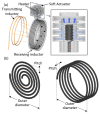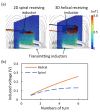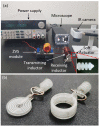Wireless Micro Soft Actuator without Payloads Using 3D Helical Coils
- PMID: 35630265
- PMCID: PMC9143378
- DOI: 10.3390/mi13050799
Wireless Micro Soft Actuator without Payloads Using 3D Helical Coils
Abstract
To receive a greater power and to demonstrate the soft bellows-shaped actuator's wireless actuation, micro inductors were built for wireless power transfer and realized in a three-dimensional helical structure, which have previously been built in two-dimensional spiral structures. Although the three-dimensional helical inductor has the advantage of acquiring more magnetic flux linkage than the two-dimensional spiral inductor, the existing microfabrication technique produces a device on a two-dimensional plane, as it has a limit to building a complete three-dimensional structure. In this study, by using a three-dimensional printed soluble mold technique, a three-dimensional heater with helical coils, which have a larger heating area than a two-dimensional heater, was fabricated with three-dimensional receiving inductors for enhanced wireless power transfer. The three-dimensional heater connected to the three-dimensional helical inductor increased the temperature of the liquid and gas inside the bellows-shaped actuator while reaching 176.1% higher temperature than the heater connected to the two-dimensional spiral inductor. Thereby it enables a stroke of the actuator up to 522% longer than when it is connected to the spiral inductor. Therefore, three-dimensional micro coils can offer a significant approach to the development of wireless micro soft robots without incurring heavy and bulky parts such as batteries.
Keywords: 3D helical inductors; liquid–gas phase changes; magnetic induction; soft actuators; wireless actuators.
Conflict of interest statement
The authors declare no conflict of interest.
Figures








References
-
- Lee C., Kim M., Kim Y.J., Hong N., Ryu S., Kim H.J., Kim S. Soft robot review. Int. J. Control Autom. Syst. 2017;15:3–15. doi: 10.1007/s12555-016-0462-3. - DOI
-
- Glasco D.L., Sheelam A., Ho N.H., Mamaril A.M., King M., Bell J.G. Editors’ choice—review—3D printing: An innovative trend in analytical sensing. ECS Sens. Plus. 2022;1:010602. doi: 10.1149/2754-2726/ac5c7a. - DOI
-
- Cheng P., Ye Y., Jia J., Wu C., Xie Q. Design of cylindrical soft vacuum actuator for soft robots. Smart Mater. Struct. 2021;30:045020. doi: 10.1088/1361-665X/abeb2f. - DOI
Grants and funding
LinkOut - more resources
Full Text Sources

